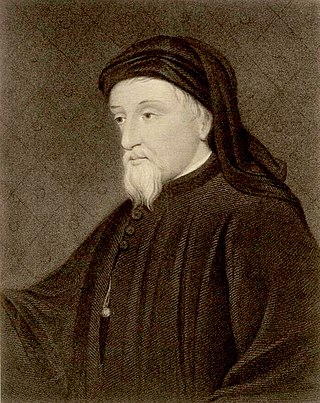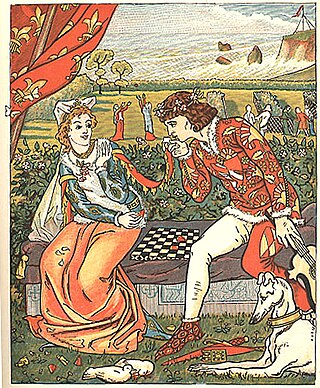Related Research Articles

The Canterbury Tales is a collection of twenty-four stories that runs to over 17,000 lines written in Middle English by Geoffrey Chaucer between 1387 and 1400. It is widely regarded as Chaucer's magnum opus. The tales are presented as part of a story-telling contest by a group of pilgrims as they travel together from London to Canterbury to visit the shrine of Saint Thomas Becket at Canterbury Cathedral. The prize for this contest is a free meal at the Tabard Inn at Southwark on their return.

Geoffrey Chaucer was an English poet, author, and civil servant best known for The Canterbury Tales. He has been called the "father of English literature", or, alternatively, the "father of English poetry". He was the first writer to be buried in what has since come to be called Poets' Corner, in Westminster Abbey. Chaucer also gained fame as a philosopher and astronomer, composing the scientific A Treatise on the Astrolabe for his 10-year-old son Lewis. He maintained a career in the civil service as a bureaucrat, courtier, diplomat, and member of parliament.

"The Parson's Tale" seems, from the evidence of its prologue, to have been intended as the final tale of Geoffrey Chaucer's poetic cycle The Canterbury Tales. The "tale", which is the longest of all the surviving contributions by Chaucer's pilgrims, is in fact neither a story nor a poem, but a long and unrelieved prose treatise on penance. Critics and readers are generally unclear what rhetorical effect Chaucer may have intended by ending his cycle in this unlikely, extra-generic fashion.

"The Knight's Tale" is the first tale from Geoffrey Chaucer's The Canterbury Tales.

"The Miller's Tale" is the second of Geoffrey Chaucer's Canterbury Tales (1380s–1390s), told by the drunken miller Robin to "quite" "The Knight's Tale". The Miller's Prologue is the first "quite" that occurs in the tales.

"The Wife of Bath's Tale" is among the best-known of Geoffrey Chaucer's Canterbury Tales. It provides insight into the role of women in the Late Middle Ages and was probably of interest to Chaucer himself, for the character is one of his most developed ones, with her Prologue twice as long as her Tale. He also goes so far as to describe two sets of clothing for her in his General Prologue. She holds her own among the bickering pilgrims, and evidence in the manuscripts suggests that although she was first assigned a different, plainer tale—perhaps the one told by the Shipman—she received her present tale as her significance increased. She calls herself both Alyson and Alys in the prologue, but to confuse matters these are also the names of her 'gossib', whom she mentions several times, as well as many female characters throughout The Canterbury Tales.

"The Franklin's Tale" is one of The Canterbury Tales by Geoffrey Chaucer. It focuses on issues of providence, truth, generosity and gentillesse in human relationships.

"The Pardoner's Tale" is one of The Canterbury Tales by Geoffrey Chaucer. In the order of the Tales, it comes after The Physician's Tale and before The Shipman's Tale; it is prompted by the Host's desire to hear something positive after the physician's depressing tale. The Pardoner initiates his Prologue—briefly accounting his methods of swindling people—and then proceeds to tell a moral tale.

"The Nun's Priest's Tale" is one of The Canterbury Tales by the Middle English poet Geoffrey Chaucer. Composed in the 1390s, it is a beast fable and mock epic based on an incident in the Reynard cycle. The story of Chanticleer and the Fox became further popularised in Britain through this means.

Sir Thopas is one of The Canterbury Tales by Geoffrey Chaucer, published in 1387. The tale is one of two—together with The Tale of Melibee—told by the fictive Geoffrey Chaucer as he travels with the pilgrims on the journey to Canterbury Cathedral. The tale concerns the adventures of the knight "Sir Thopas" and his quest to win the elf-queen.

The General Prologue is the first part of The Canterbury Tales by Geoffrey Chaucer. It introduces the frame story, in which a group of pilgrims travelling to the shrine of Thomas Becket in Canterbury agree to take part in a storytelling competition, and describes the pilgrims themselves.

"The Squire's Tale" is a tale in Geoffrey Chaucer's The Canterbury Tales. It is unfinished, because it is interrupted by the next story-teller, the Franklin, who then continues with his own prologue and tale. The Squire is the Knight's son, a novice warrior and lover with more enthusiasm than experience. His tale is an epic romance, which, if completed, would probably have been longer than rest of the Tales combined. It contains many literary allusions and vivid descriptions.

A parvis or parvise is the open space in front of and around a cathedral or church, especially when surrounded by either colonnades or porticoes, as at St. Peter's Basilica in Rome. It is thus a church-specific type of forecourt, front yard or apron.
"The Summoner's Tale" is one of The Canterbury Tales by Geoffrey Chaucer.

"The Monk's Tale" is one of The Canterbury Tales by Geoffrey Chaucer.

A beaver hat is a hat made from felted beaver fur. They were fashionable across much of Europe during the period 1550–1850 because the soft yet resilient material could be easily combed to make a variety of hat shapes. Smaller hats made of beaver were sometimes called beaverkins, as in Thomas Carlyle's description of his wife as a child.

In the Kingdom of England from the 12th to 15th centuries, a franklin was a member of a certain social class or rank. In the Middle English period, a franklin was simply a freeman; that is, a man who was not a serf. In the feudal system under which people were tied to land which they did not own, serfs were in bondage to a member of the nobility who owned that land. The surname "Fry", derived from the Old English "frig", indicates a similar social origin.

Contact between Geoffrey Chaucer and the Italian humanists Petrarch or Boccaccio has been proposed by scholars for centuries. More recent scholarship tends to discount these earlier speculations because of lack of evidence. As Leonard Koff remarks, the story of their meeting is "a 'tydying' worthy of Chaucer himself".
The Canterbury Tales is a collection of stories, mostly in verse, written by Geoffrey Chaucer chiefly from 1387 to 1400. They are held together in a frame story of a pilgrimage on which each member of the group is to tell two tales on the way to Canterbury, and two on the way back. Fewer than a quarter of the projected tales were completed before Chaucer's death. It is uncertain in what order Chaucer intended the tales to appear; moreover it is very possible that, as a work-in-progress, no final authorial order of tales ever existed.

The Squire is a fictional character in the framing narrative of Geoffrey Chaucer's Canterbury Tales. He is squire to the Knight and is the narrator of The Squire's Tale or Cambuscan. The Squire is one of the secular pilgrims, of the military group. The Knight and the Squire are the pilgrims with the highest social status. However his tale, interrupted as it is, is paired with that of the Franklin. The Squire is a candidate for the interrupter of The Host in the epilogue of the Man of Law's Tale.
References
- 1 2 Sarkar, Ajoy K.; Tortora, Phyllis G.; Johnson, Ingrid (2021-11-04). The Fairchild Books Dictionary of Textiles. Bloomsbury Publishing USA. p. 173. ISBN 978-1-5013-6508-9.
- ↑ An Illustrated Dictionary Of Art. p. 134.
- 1 2 Chaucer, Geoffrey (1892). Chaucer, the Prologue, the Knightes Tale the Nonne Preestes Tale from the Canterbury Tales. At the Clarendon Press. p. 155.
- ↑ McClellan, Elisabeth (1906). Historic dress 1607 to 1800. Robarts - University of Toronto. London : J. Lane. p. 386.
- ↑ Mack, Maynard (1956). World Masterpieces. Norton. p. 724.
- ↑ Davis), Mrs Aria (Eliza (1906). Costume: Fanciful, Historical, and Theatrical. Macmillan and Company, limited. p. 108.
- ↑ Chaucer, Geoffrey (1892). Chaucer, the Prologue, the Knightes Tale the Nonne Preestes Tale from the Canterbury Tales. At the Clarendon Press. p. 14.